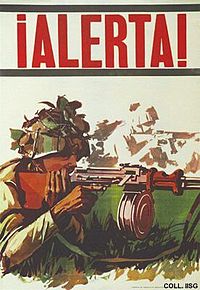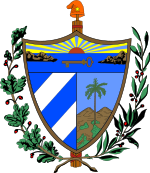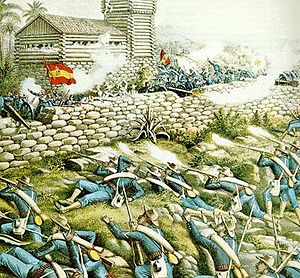- Military history of Cuba
-
Military of Cuba Components Cuban Air Force Cuban Army Cuban Navy Ranks of the Cuban Military Air Force ranks and insignia Army ranks and insignia Navy ranks and insignia History of the Cuban Military Military history of Cuba The Military history of Cuba begins with the island's conquest by the Spanish and its battles afterward to gain its independence. Since the Communist takeover by Fidel Castro in 1959, Cuba has been involved with many major conflicts of the Cold War in Africa and Latin America where it had supported Marxist governments and rebels from liberation movements who were opposed to their colonial masters and/or allies of the United States.
Ten Years' War
The Ten Years' War was the first of three wars that Cuba fought against Spain for its independence. The Ten Years' War began when Carlos Manuel de Céspedes and his followers of patriots from his sugar mill La Demajagua began an uprising. The war ended with the signing of the Pact of Zanjón.
Cuban War of Independence
The Cuban War of Independence was the last major uprising by Cuban Nationalists against the Spanish Colonial Government. The conflict ended with American intervention during the Spanish-American War.
Spanish-American War
The Spanish-American War was a major war fought by the USA against Kingdom of Spain in Cuba, Puerto Rico, and the Philippines. The war was triggered with the sinking of the USS Maine in Havana Harbor. Cuban rebels fought alongside American troops during the major battles. The war lasted 10 weeks.
Cuba was occupied by US military troops on July 17, 1898. In the Treaty of Paris (1898), Spain renounced its sovereignty over Cuba without naming a receiving country. Cuba then established its own civil government, which was recognized by the United States as the legal government of Cuba upon the announcement of the termination of United States Military Government (USMG) jurisdiction over the island on May 20, 1902. This date is celebrated as Independence day for the Republic of Cuba.
1952 Coup
Military strongman Fulgencio Batista staged a coup on March 10, 1952, removing Carlos Prío Socarrás from power. Cubans in general were stunned, but remembering the bloodshed of the Batista's rule in the 1930s, they were reluctant to fight. Batista created a consultative council from pliable political personalities of all parties who appointed him President months before elections were to be held. Batista’s past democratic and pro-labor tendencies and the fear of another episode of bloody violence gained him tenuous support from the bankers, and the leader of the major labor confederation.
The Cuban Revolution
The Cuban Revolution started as an uprising that resulted in the overthrow of the Fulgencio Batista government on January 1, 1959 by Fidel Castro and other revolutionary elements in the country. The Revolution began on July 26, 1953, when a group of armed guerrillas attacked the Moncada Barracks.
From 1956 through the middle of 1958, Castro and his forces staged successful attacks on Batista garrisons in the Sierra Maestra mountains. Che Guevara and Raúl Castro helped to consolidate rebel political control in the mountains through executions of Batista Loyalists and potential rivals to Castro. The irregular and poorly armed rebels harassed the Batista forces in the foot hills and the plains of Oriente Province.
The final blow to Batista government came during the Battle of Yaguajay. Castro’s forces were able to capture the garrisons at Santa Clara along with the second largest city. As a result Batista fled the country and Castro came into power.
Bay of Pigs Invasion
Main article: Bay of Pigs Invasion Cuban poster warning of US invasion displayed shortly before the Bay of Pigs invasion
Cuban poster warning of US invasion displayed shortly before the Bay of Pigs invasion
The Bay of Pigs Invasion (known as La Batalla de Girón in Cuba), was an unsuccessful attempt by a U.S.-trained force of Cuban exiles to invade southern Cuba with support from U.S. armed forces to overthrow the Cuban government of Fidel Castro. The plan was launched in April 1961, less than three months after John F. Kennedy assumed the presidency in the United States. The Cuban armed forces, trained and equipped by Eastern Bloc nations, defeated the exile combatants in three days. Bad Cuban-American relations were exacerbated the following year by the Cuban Missile Crisis.
Cuban Missile Crisis
Main article: Cuban Missile CrisisThe Cuban Missile Crisis was a confrontation between the Soviet Union and the United States over nuclear missiles that were deployed in Cuba. The missiles were ostensibly placed to protect Cuba from further attacks by the United States after the failed Bay of Pigs Invasion, and were rationalized by the Soviets as equivalent to the U.S. placing deployable nuclear warheads in Turkey.
The crisis began when U.S. reconnaissance imagery revealed Soviet nuclear missile installations on the island and ended fourteen days later when the Americans and Soviets came to the agreement that if the Soviet installations in Cuba were dismantled, American installations in Turkey would also be dismantled.
Congo Crisis
The Congo Crisis was a period of turmoil in the Congo that began with national independence from Belgium and ended with the seizing of power by Joseph Mobutu. During the Congo Crisis, Cuban Expedition led by Che Guevara trained Marxist Rebels to fight against the weak central government of Joseph Kasa-Vubu along with the forces of Mobutu Sese Seko. This would be the Cuba's first military action overseas and in Africa.
Bolivia Insurgency
During the 1960s, the National Liberation Army began a Communist insurgency in Bolivia. The National Liberation Army was established and funded by Cuba and led by Che Guevara.
The National Liberation Army was defeated and Che Guevara was captured by the Bolivia government aided by the CIA. Bolivian Special Forces were informed of the location of Guevara's guerrilla encampment. On October 8, the encampment was encircled, and Guevara was captured and later executed by Bolivian forces.
Eritrean War
Main article: Eritrean War of IndependenceCubans trained Eritreans but later, in a political reversal, trained Ethiopnian Marxist forces who were fighting against Eritreans.
Yom Kippur War
The Yom Kippur War was the fifth major conflict between Israel and the neighboring Arab States. Cuba deployed 1,500 troops, including tank and helicopter crews, to support the Arabs during the war. Precise Cuban casualty numbers are unknown.[1]
Ogaden War
The Ogaden War was a conflict between Somalia and Ethiopia between 1977 and 1978. Fighting erupted in the Ogaden region as Somalia attempted to occupy the area. The conflict ended with an Ethiopian victory.
When the USSR began to support the Ethiopian Derg government instead of the Somali government, other Communist nations followed. The Cuban Military deployed 15,000 combat troops along with aircraft to support the Derg government and the USSR military advisors in the region.
Cuban Military Actions in Angola (1961-2002)
Main article: Cuba in AngolaBetween 1961 until 2002, the Cuban Military provided support for the left wing MPLA movement in a series of civil wars. During these conflicts the MPLA emerged victorious due in part to the substantial aid received from Cuba.
Angolan War of Independence
The Angolan War of Independence was a struggle for control of Angola between gurella movements and Portuguese colonial authority. Cuba supplied the MPLA rebels with weapons and soldiers to fight. Cuban military would fight alongside the MPLA in major battles.
South African Border War
The so-called South African Border War was a conflict that took place in South-West Africa (Today independent nation of Namibia) between apartheid South Africa army and its allied forces of UNITA against namibian SWAPO and Angolan MPLA.
During the conflict, Cuba sent soldiers to aid Angola. The Cuban army had a major involvement in some of the most important battles including Battle of Cuito Cuanavale.
Angolan Civil War
The Angolan Civil War was a 27-year civil war that devastated Angola following the end of Portuguese colonial rule in 1974. The conflict was fought by the MPLA against UNITA and FNLA. MPLA was aided by Cuba and the USSR and UNITA and FNLA were supported by South Africa, United States and Zaire. It became Africa's longest running conflict. The conflict was only formally brought to an end in 2002 with the death of UNITA-Leader Jonas Savimbi.
Invasion of Grenada
722 Cuban soldiers were deployed in Grenada During the Invasion of Grenada by U.S. troops in 1983. The Cuban government sent these troops there to support the leftist government of the country. Cuban losses during the conflict where 25 killed, 59 wounded, and 638 captured. In 2008, the Government of Grenada announced a move to build a monument to honor the Cubans killed during the invasion. At the time of the announcement the Cuban and Grenadian government are still seeking to locate a suitable site for the monument.
Salvadoran Civil War
The Salvadoran Civil War was fought by the El Salvador government against various left-wing rebels. Cuba supplied the rebels with weapons and advisors.
Nicaraguan Civil War
During the Sandinista revolution and the following Civil War, Cuba gave aid and support to the Sandinista government of Daniel Ortega. The Sandinista government was fighting the American backed Contras. The conflict ended with the 1990 presidential election were Ortega lost to Violeta Barrios de Chamorro
References
- ^ Perez, Cuba, Between Reform and Revolution, p. 377-379
External links
Military history of North America Sovereign states - Antigua and Barbuda
- Bahamas
- Barbados
- Belize
- Canada
- Costa Rica
- Cuba
- Dominica
- Dominican Republic
- El Salvador
- Grenada
- Guatemala
- Haiti
- Honduras
- Jamaica
- Mexico
- Nicaragua
- Panama
- Saint Kitts and Nevis
- Saint Lucia
- Saint Vincent and the Grenadines
- Trinidad and Tobago
- United States
Dependencies and
other territories- Anguilla
- Aruba
- Bermuda
- Bonaire
- British Virgin Islands
- Cayman Islands
- Curaçao
- Greenland
- Guadeloupe
- Martinique
- Montserrat
- Puerto Rico
- Saint Barthélemy
- Saint Martin
- Saint Pierre and Miquelon
- Saba
- Sint Eustatius
- Sint Maarten
- Turks and Caicos Islands
- United States Virgin Islands
Categories:
Wikimedia Foundation. 2010.



